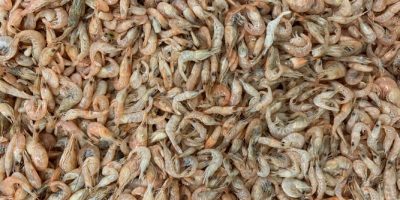Bass fishing is regarded as an excellent pastime for introducing newcomers to the sport of fishing. There are enough lucky catches to keep a bass angler returning for more. When it comes to bass fishing, choosing and utilizing the appropriate lures may make all the difference.
The Finest Smallmouth Bass Fishing Lures
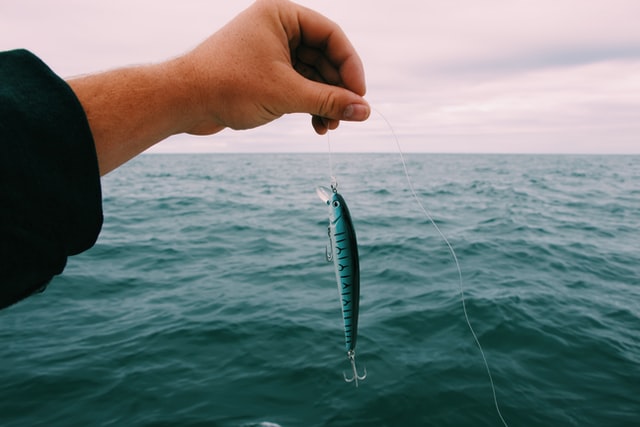
🎣The Blade Baits
Fishing blade baits for smallmouth is a fantastic cold water strategy but can be highly productive during the summer months too. It’s a bait that fish don’t see very often, which is usually positive. When working a blade bait, lift the rod tip and then drop it while reeling in the slack.
This action causes it to swim and vibrate upward before sinking and fluttering down. This looks like an injured baitfish and is frequently shattered in the fall. If you’re hunting bass in really cold water, you’ll want to work this bait much slowly.
The idea is to let it sink to the bottom and then sit there. Again you’ll want to lift it from the bottom now and then. I know it seems monotonous, but getting a bite in cold water from sluggish fish requires a lot of patience.
🎣The Small Soft Plastics
Soft plastics, at least the ones we’ll be discussing here, all fall into the classification of fine fishing baits. These are mostly fished in the same way, by pulling and bouncing them along the base. These baits work well on rocky and sandy bottoms, where smallmouth prefer to cruise in pursuit of gobies.
The main disadvantage is that they occasionally become entangled between rocks, therefore they are best fished from a boat so that you can retrieve them. To keep these soft plastics on the bottom, they should all be connected with a jig head. This also holds the bait’s head down and the tail end looking upwards.
The benefit of using this technique is that the baits will seem like a gobie or crayfish, which is what a smallmouth is expecting to see. Depending on the location you are fishing, these lures can also be rigged weedless.
🎣The Jigs
Jigs are the most preferred and greatest all-around smallmouth bass lure for two reasons. There is no bad time of year to go jig fishing for smallmouth bass. Second, jigs are well-known for producing largemouth bass, therefore they have a great possibility for landing a prize smallmouth.
The two most prevalent varieties of jigs are a normal rubber skirted bass jig and a hair jig, similar to a bucktail jig. This is where baitcasting equipment comes into play.
🎣The Jerkbaits
The jerk bait is another early-season smallmouth bass top pick. Jerkbaits are excellent cold water baits and are ideal for catching smallmouth bass in the cooler water temperatures of early spring. It works so well because they can be manipulated very slowly, which is especially true for suspended jerk baits.
Natural colors are excellent, particularly if you can match the kind of baitfish that smallmouth consumes in that body of water. Jerkbaits are excellent at eliciting response strikes, which is an added benefit when fishing with them.
🎣The Crankbaits and Spinnerbaits
Despite their dissimilar appearances, we grouped these two lures since they are both power fishing lures. When the fish are active, crankbaits and spinnerbaits are highly prevalent in smallmouth lures. It is particularly successful to burn these baits around rock heaps and weed margins.
These are better possibilities for deeper water, ranging from six feet to thirty feet or more. If you’re fishing on a rough bottom, attempt to get the crankbait to hit down into the rocks, diverting the bait with the lure’s beak.
These are also excellent alternatives if you are fishing a grassy bottom. A smallie will often attack you if you ride the crankbait right along with the tips of the grass. If the crankbait is taking up weeds, a spinnerbait is a more weedless choice.
🎣The Topwater Lures
Smallmouth bass may make largemouth bass seem like snails while they are furiously eating. And, if the conditions are favorable, there’s no better way to capture them while they’re active than with topwater lures. Topwater fishing for smallmouth bass is greatest in the morning and late afternoon.
Unless it is gloomy and there is a small chop on the sea, midday may also be extremely fruitful. Walk the dog lures are some of the greatest topwater bait types for smallmouth. Natural designs that are somewhat translucent are the ideal colors to utilize in clear water. This will look to be a grapple baitfish on the surface and an easy meal.
A Beginner’s Introduction to Bass Fishing

Many of us were hooked the minute we caught our first fish. All jokes aside, bass fishing is an addictive and surprisingly complex sport. If you’re new to bass fishing, you probably want to know how to capture more bass and bigger bass. The following are the fundamentals of the activity.
➖ Where to Find Bass
The short explanation is that they reside near structure-based cover. When anglers explain where to find bass on a lake or body of water, cover and structure are two of the most commonly used adjectives. Knowing the distinction between cover and structure is essential for understanding where bass lives and how to catch them.
➖ What do Bass Eat
Bass will consume almost anything in the water that moves. Smaller fish are their most usual regular meals. They will also consume anything that moves over their heads. When fishing for bass, try to match the hatch as much as possible.
This word refers to selecting a bait or lure that corresponds to what you believe the bass are eating. If you’re fishing along the coastline and there are a lot of frogs wandering about, a hollow-bodied frog or rat is a decent choice.
➖ What Lures do you Need
Many new bass anglers become overly comfortable with one approach or another. Make an effort to be as well-rounded as possible. Any lure will work for them, and it is critical to be adaptable in order to narrow down what would work for you.
➖ When is the best time to Fish
The time of day, seasons, weather, and moon phase are all crucial in understanding the bass activity. Many new fishermen do not devote enough time to learning about how bass interact with their surroundings.
During the summer, larger bass will only eat a couple of times each day, usually early in the morning and late evening or at night. Winter is the polar opposite; they will feed minimally, but only during the warmer hours of the day. Understanding when to fish for bass is critical to know how to catch bass all year.
➖ How temperature affects the Bass
This can have a significant impact on where bass are found at various times of the year. The northern end of a lake warms up the fastest in the spring, pushing the bass’ spawning cycle into high gear first. This means that the bass will move up shallow on the north end faster than the south end.
The colder water in the autumn will warm up the fishing faster and school up enormous balls of baitfish that bass will feast on before the winter. And because water temperature affects bass metabolism, it influences how they feed. Every time you get in the water, you should pay special attention to the water temperature.
Putting Together a Bass Fishing Pole
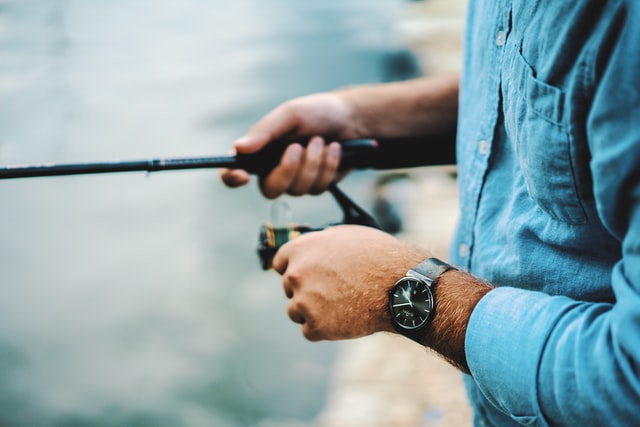
⚫Selecting the Best Rod, Reel, and Line
If you are a Beginner use a Spinning Reel and Rod
If you’re new to bass fishing, spinning rods and reels are the best way to get started. Spinning rods and reels only work with spinning rods and reels only work with spinning rods. And because of the minimal friction, a spinning reel lies on the bottom of the rod and enables you to cast lightweight baits long distances.
If you are Experienced use a baitcasting Rod and Reel
Baitcasting rod and reel sets enable you to utilize larger lures and lines. Pick a good baitcasting reel and a graphite rod to offer yourself greater force while fighting fish and aquatic plants. Baitcasting reels are scaled on the rod’s upper side.
Casting with a spinning rod and reel should be mastered before moving on to a baitcasting reel, as casting with this type of reel is more challenging.
Choose a Nylon Monofilament Line
The monofilament line is inexpensive and simple to use for beginning bass anglers. Casting is simple with a spinning rod and reel combination. The disadvantage of a monofilament line is that it is more easily damaged or broken.
Use Fluorocarbon or Braided Line
Fluorocarbon and braided lines are both more durable than monofilament and perform well with baitcasting rods. Braid is the most difficult line to cast, so use it only if you are sure of your baitcasting abilities.
Load the Line onto the Reel
For spinning reels, fill the spool of the reel. It is critical to get enough line on the reel so that you can make a long cast. If you overload the spool of a spinning reel with a line, the line will bounce off. If you fill up a baitcasting reel, you will hear an unusual sound when casting.
⚫Incorporating Fundamental Hooks and Lures
Attach a Worm Hook
Insert the line through the ceramic ends on the fishing pole after releasing the drag on the reel. Use a Palomar knot to secure the hook to the line. A worm hook may be used with both live and rubber worms. Worms are an excellent bait for bass because they will frequently attack the worm as it descends through the water.
Create a Texas Rig
Place a cone-shaped weight on the line with the tip facing the end. Tie on a worm hook and put on a rubber worm so that the hook’s tip is hidden. As you fish for bass, the cone-shaped weight will travel up and down the line, creating line action that they will be drawn to. The Texas rig is the most popular and widely used bass fishing gear.
Make use of a Carolina Rig
Tie a Palomar knot around an offset worm hook and put any sort of rubber bait onto the hook. When the bass is wary of your bait, the Carolina rig is ideal for getting through foliage where they are hiding. There is no need to utilize the Carolina rig if fish are attacking your bait on a Texas rig or a standard worm hook arrangement.
Make a Drop Shot Rig
To leave a tag end, double the line before passing it through the eyes of a worm hook. On the hook, tie a Palomar knot and then thread the tag end through the eye. Attach a weight to the tag line and a rubber worm or other bait on the hook.
The hook should protrude from the line at a 90-degree angle. This rig configuration works well for bass fishing as well as bottom feeders like catfish.
Fishing for Bass 101
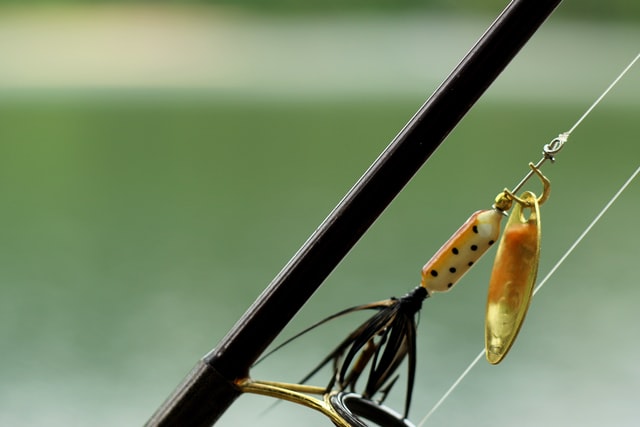
Now that you’ve figured out how to set up your gear, it’s time to catch some bass. Nature is unanticipated, but if you comprehend the behaviors of bass and the conditions you’re fishing in, you may use the most effective tactics and equipment to land a great harvest.
✔️Comprehend the Behaviors of Bass during Each Season
Spring and summer offer excellent fishing opportunities because bass eats nearer to shore in the morning and travel out into open water near stream troughs and features later in the day. During the winter and cooler temperatures, bass will put up little energy and will only bite when your bait is directly within their striking zone.
✔️Improve your Terrain
Relying on the weather, time of day, and phase of their spawning cycle, bass prefer to stay close to certain areas or disguise within the debris. Larger bass frequently congregates beneath docks.
✔️When you want to Cover a lot of Water, use Crankbaits
Crankbaits are available with or without a lip, and each is efficient depending on the depth and pace with which you reel. The form of your crankbait impacts how much activity you will receive, which is crucially dependent on the water temperature because the bass is less active in lower temps.
✔️Adjust your Line to the Diving Depth
Match the appropriate size of line to your crankbait based on how in-depth you want the bait to run.
✔️Place your bait in Close Proximity to Visible Bushes
Bass congregate around and beneath the structure to wait for an ambush feeding opportunity. As your casting technique improves, try bouncing your bait off of obstacles to eliciting a reflex strike from a nearby bass. When the bass is hungry or agitated, they will hit lures.
✔️Line and Bait should be Cast Parallel to the Coast
This will offer your lure/bait more time in the striking zone and, over time, will boost your strike percentages since you’re exposing your bait to more fish. A wise angler will work the rates, but don’t be disheartened if you don’t get a bite.
✔️Imitate Chaotic Movements
When utilizing topwater lures, do this to elicit a feeding and agitation reaction from the bass. When using a walker lure, make a back-and-forth or zig-zag motion on the surface of the water. Swivel your wrist and rod tip downwards at a sharp curve, then swiftly return the rod tip to the lure so it drifts. Make a series of quick snaps to move the bait from left to right.
✔️Lift and Lower the Rod
Use the same strategy as you would when fishing with a jig while fishing with a plastic/rubber lure. Plastic or rubber lures should not be reeled in but should be retrieved with purpose by raising and lowering the rod. Cast out and allow plenty of time for the line to reach the bottom. Lift the rod tip carefully till it points straight up after the lure has struck the base and you have given it a twitch.
Prominent Types of Bass
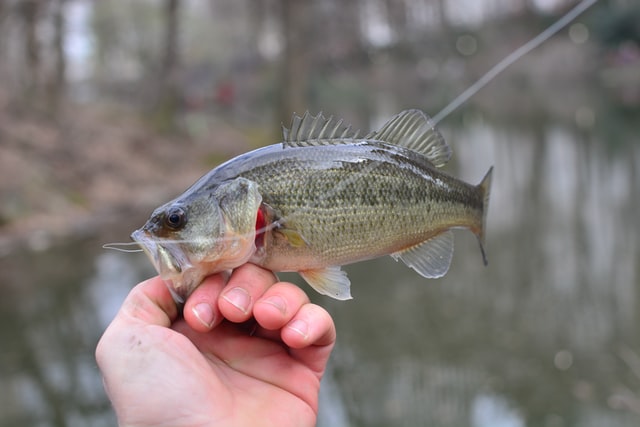
🐟 The Largemouth Bass
They’ll attack fish, insects, and even tiny birds with ferocity, but they’ll avoid the most enticing baits if they’ve seen them before. They don’t have any unusual fins or vibrant color patterns.
🐟 The Smallmouth Bass
Smallmouth Bass may not garner as much attention as their larger-mouthed brethren, but they are equally deserving of it. They like cooler water with a stronger current. Both species can be found in the same location, but one is always more dominant.
🐟 The Spotted Bass
Spotted Bass like water between what their renowned cousins prefer. They’re essentially the Black Bass family’s “baby bear.”
🐟 The White Bass
They’re not as violent as Stripers and not as cunning as Black Bass. They prefer clean, at least 10-foot-deep water. They’re ideal for children and beginners.
🐟 The Yellow Bass
Yellow Bass are among the tiniest members of the Bass family. They rarely weigh more than a pound and don’t put up much of a fight. Even inexperienced anglers will have little trouble catching one.
Frequently Asked Questions
Q: In a lake, how do you capture smallmouth bass?
A: Rapid movements lure such as spinnerbaits in white or chartreuse, or medium-diving crankbaits, will spread the fish around the gravel banks of the streams and on the main lake.
Q: What is the finest bass bait for a lake?
A: Fish and crawfish work nicely as live bait since these are what bass typically consume. The finest artificial baits are those that resemble their target in some manner.
Q: What are the favorite colors of smallmouth bass?
A: Brown, green pumpkin, black, white, chartreuse, and yellow are the greatest colors for capturing a bass.
Q: What time of day is ideal for catching smallmouth bass?
A: Smallmouth bass are most active during the day from dawn until mid-morning, and in the late afternoon from 3 hours before sunrise until nightfall.
Q: How frequently do smallmouth bass eat?
A: Smallmouth bass eats mostly during the day, with the most active feeding occurring around dawn and dusk.
Final Thoughts
There are several sorts of baits available. It is critical to understand which ones will work in your location. There are also numerous varieties of bass fish that will attract various types of lures. The most essential thing to remember is that you understand how to utilize them correctly and include them in your bass fishing trips.


